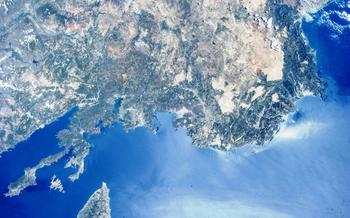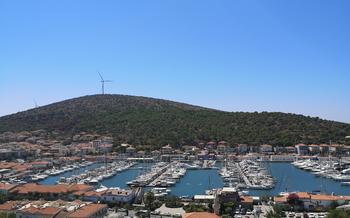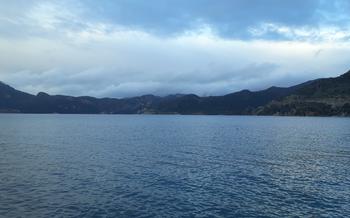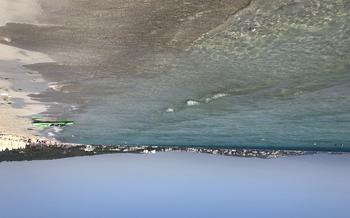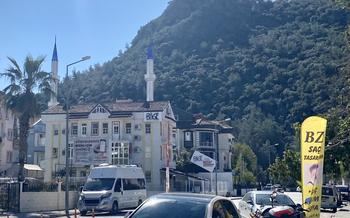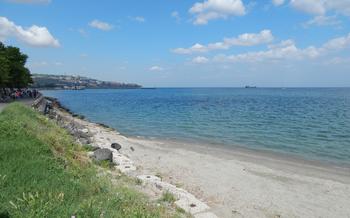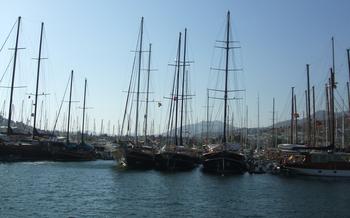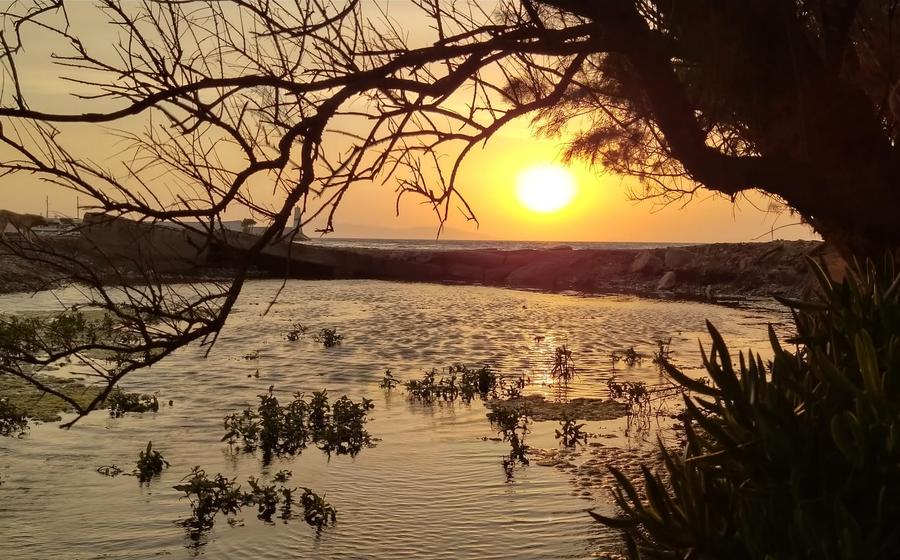
Ilica Waterfall
- A Paradise on Earth
- Unveiling the Ilica Waterfall
- Exploring the Waterfall's Surroundings
- Tips for Visiting the Ilica Waterfall
- History of Ilica Waterfall
- The Best Time to Visit the Ilica Waterfall
- Exploring the Ilica Village
- Ilica Waterfall in Turkish Culture
- Off the Beaten Path
- Supporting Sustainable Tourism
- Insider Tip
A Paradise on Earth
Datça, a picturesque peninsula located on the Turkish Riviera, is a hidden gem waiting to be discovered. With its stunning natural beauty, rich history, and warm hospitality, Datça offers travelers an unforgettable experience.
Getting to Datça is a breeze. The nearest international airport is in Dalaman, approximately 5 hours away by car. From Dalaman, you can take a shuttle bus or rent a car for a scenic drive along the coast.
Accommodation options in Datça are diverse, catering to every budget and preference. From cozy guesthouses to luxurious resorts, you'll find the perfect place to rest your head and immerse yourself in the local culture.
Pack light and airy clothing for the warm Mediterranean climate. A swimsuit, sunscreen, and comfortable shoes are essential for exploring the stunning beaches and hiking trails. Don't forget your camera to capture the breathtaking scenery and create lasting memories.
The best time to visit Datça is from April to October when the weather is at its best. The summer months offer warm temperatures perfect for swimming, sunbathing, and enjoying outdoor activities. In the shoulder seasons (spring and autumn), the weather is milder, making it ideal for hiking, cycling, and exploring the historical sites.
Unveiling the Ilica Waterfall
According to local legend, the Ilica Waterfall was created by the tears of a heartbroken nymph named Ilica. She wept so profusely that her tears formed a river that cascaded down the mountainside, creating the waterfall we see today. The waterfall is said to possess healing properties, and many people believe that bathing in its waters can cure various ailments. The natural beauty of the waterfall is also undeniable. The crystal-clear water cascades over a series of smooth rocks, creating a mesmerizing sight. The surrounding area is lush with vegetation, and the air is filled with the sound of birdsong. The best time to visit the Ilica Waterfall is during the spring or fall when the weather is mild, and the crowds are smaller.
Exploring the Waterfall's Surroundings
Beyond the captivating allure of the Ilica Waterfall, an array of enticing destinations beckons, promising an unforgettable journey through nature's wonders. Immerse yourself in the pristine beauty of Ilica Beach, where golden sands meet crystal-clear turquoise waters, inviting you to bask in the sun's warmth or indulge in invigorating water sports.
Venture further to the Hisarönü Gulf, a breathtaking expanse of shimmering waters dotted with picturesque islands. Explore the secluded coves and hidden beaches that pepper this unspoiled paradise, discovering hidden gems that will leave you breathless. Dive into the depths of history at the Knidos Ancient City, where ancient ruins and artifacts whisper tales of civilizations past. Stroll through the remnants of this once-thriving metropolis, marveling at the architectural wonders that have stood the test of time.
Don't miss the opportunity to traverse the Datça Peninsula, a haven for nature enthusiasts and adventure seekers. Embark on a scenic hike through lush forests, encountering diverse flora and fauna, and culminating in breathtaking panoramic vistas that will forever etch themselves into your memory.
Tips for Visiting the Ilica Waterfall
Be prepared for the terrain. The path to the waterfall can be rocky and uneven, so wear comfortable shoes with good traction. The waterfall itself is also surrounded by rocks, so be careful when walking around.
Pack for the weather. The weather in Datça can be hot and sunny, even in the shoulder seasons. Bring a hat, sunglasses, and sunscreen to protect yourself from the sun. You may also want to bring a raincoat or umbrella in case of rain.
Bring plenty of water. There are no shops or restaurants near the waterfall, so be sure to bring plenty of water to stay hydrated.
Be respectful of the local culture. Turkey is a Muslim country, so be respectful of local customs and traditions. Dress modestly, and avoid public displays of affection.
Leave no trace. Please be respectful of the environment and leave no trace of your visit. Pack out all your trash, and be careful not to damage the plants or animals.
History of Ilica Waterfall
The geological origins of the Ilica Waterfall can be traced back millions of years, when the region was subjected to intense tectonic activity. This activity resulted in the formation of numerous faults and fractures in the earth's crust, allowing hot springs to rise to the surface. Over time, the minerals in the water deposited themselves around the springs, creating the unique travertine terraces that characterize the waterfall.
In ancient times, the region around the Ilica Waterfall was home to the Greek city of Loryma. The city was founded in the 7th century BC and quickly became an important center of trade and culture. The waterfall itself was a sacred site to the Greeks, who believed that it possessed healing properties. They would often visit the waterfall to bathe in its waters and seek relief from various ailments.
During the Ottoman Empire, the Ilica Waterfall continued to be a popular destination for both locals and visitors from afar. The Ottomans built several bathhouses and other structures around the waterfall, allowing people to enjoy its therapeutic waters in a more comfortable setting. The waterfall also became a popular spot for picnics and other recreational activities.
In the modern era, the Ilica Waterfall has remained a popular tourist destination. In recent years, the waterfall has been extensively renovated and developed, with the addition of new walkways, viewing platforms, and other amenities. The waterfall is now a major attraction in the Datça region, drawing thousands of visitors each year.
The Best Time to Visit the Ilica Waterfall
The ideal time to visit the Ilica Waterfall is during the shoulder seasons, spring (April-May) and autumn (September-October), when the weather is still warm and pleasant, but the crowds are smaller. The summer months (June-August) can be very hot and crowded, making it difficult to fully enjoy the waterfall's beauty and serenity.
In the winter (November-March), the weather can be unpredictable, with occasional rain and cold spells. However, this can be a magical time to visit the waterfall, as the surrounding landscape is transformed into a winter wonderland.
The best time of day to visit the Ilica Waterfall is early in the morning or late in the afternoon, when the sun is not as intense and the crowds are smaller. This is also the best time to see the waterfall at its most beautiful, as the sunlight creates a stunning play of light and shadow on the cascading water.
Exploring the Ilica Village
Nestled in the heart of the Datça Peninsula, the charming village of Ilica beckons travelers with its rich history, vibrant culture, and warm hospitality. Founded centuries ago by Greek settlers, Ilica has preserved its unique identity, blending ancient traditions with modern amenities.
Strolling through the village's narrow cobblestone streets, visitors are greeted by whitewashed houses adorned with colorful bougainvillea flowers. The air is filled with the tantalizing aromas of freshly baked bread wafting from local bakeries and the sound of lively conversations echoing from traditional coffee shops.
Ilica's culinary scene is a delight for food enthusiasts, offering a tempting array of local delicacies. Visitors can indulge in freshly caught seafood dishes, savor the flavors of homemade olive oil, and sample traditional Turkish sweets such as güllaç and sütlaç.
Beyond its culinary delights, Ilica is renowned for its traditional crafts. Skilled artisans showcase their mastery in intricate embroidery, weaving, and pottery, creating unique souvenirs that capture the essence of the village's heritage.
The heart of Ilica lies in its people, who are known for their warmth, friendliness, and genuine desire to share their culture with visitors. Whether it's a lively conversation over a cup of Turkish coffee or an invitation to join in a traditional dance, the people of Ilica are always eager to welcome newcomers.
Ilica Waterfall in Turkish Culture
The Ilica Waterfall holds a special place in Turkish culture, deeply intertwined with mythology, folklore, art, and literature.
Off the Beaten Path
While the Ilica Waterfall is a popular tourist destination, there are still plenty of hidden gems to be found in the surrounding area. For those looking to get off the beaten path, here are a few suggestions:
-
Secret Swimming Spots: In addition to the main waterfall pool, there are several smaller, more secluded swimming spots hidden among the rocks. These spots are perfect for escaping the crowds and enjoying a relaxing swim in the cool, refreshing water.
-
Hiking Trails Less Traveled: The area around the Ilica Waterfall is crisscrossed with hiking trails, many of which are relatively unknown to tourists. These trails offer stunning views of the waterfall and the surrounding countryside.
-
Unique Viewpoints: There are several hidden viewpoints that offer unique perspectives of the Ilica Waterfall. These viewpoints are often difficult to find, but they are worth the effort for the breathtaking views they offer.
-
Local Guide: If you want to explore the Ilica Waterfall and its surroundings in a truly unique way, consider hiring a local guide. A guide can show you the best-hidden spots, tell you about the local history and culture, and help you avoid the crowds.
Supporting Sustainable Tourism
As a responsible traveler, it is crucial to minimize your ecological footprint and support the local community while exploring the Ilica Waterfall. Here are some tips for sustainable tourism:
- Tread Lightly: Choose walking or cycling over driving whenever possible to reduce carbon emissions. Respect the natural environment by avoiding littering, damaging plants, or disturbing wildlife.
- Support Local Businesses: Opt for locally-owned guesthouses, restaurants, and tour operators to contribute directly to the community's economy. Purchase souvenirs from local artisans to encourage traditional crafts and cultural preservation.
- Give Back: Volunteer your time or donate to local organizations working to protect the environment or support community development projects. Your contribution can make a meaningful difference.
- Respect Local Customs: Be mindful of local traditions and customs. Dress appropriately, ask permission before taking photos of people, and avoid behaviors that may be considered disrespectful.
Insider Tip
- For a magical experience, plan your visit to the Ilica Waterfall around sunset. As the sky transforms into a canvas of vibrant hues, the waterfall's cascading waters illuminate with a golden glow, creating a breathtaking spectacle. Find a secluded spot on the rocks and let the symphony of colors wash over you, leaving an unforgettable memory etched in your heart.
